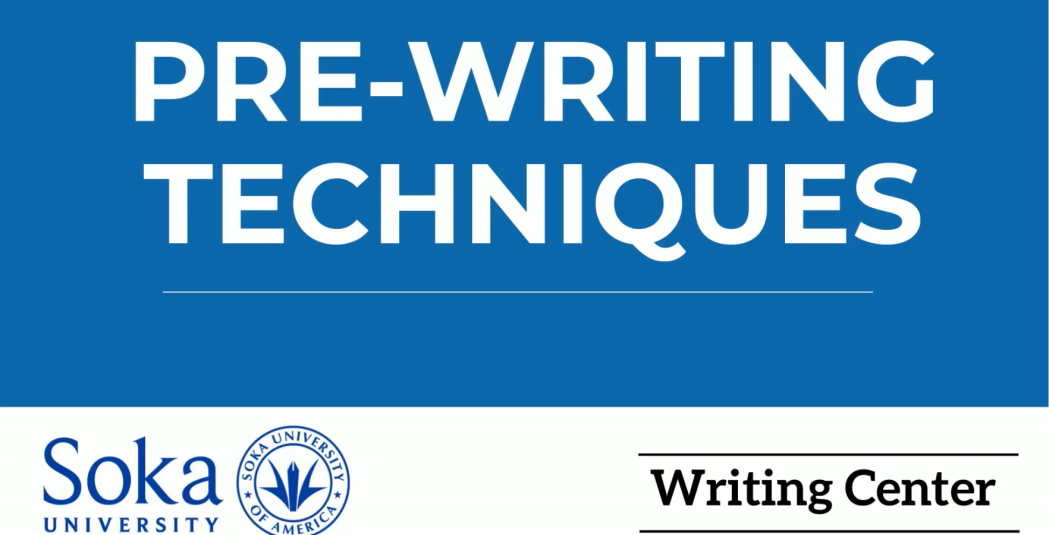Pre-Writing Techniques

Many students find it difficult to start a writing project. They may have difficulty thinking of what to write, so they put it off. But procrastination often leads to more stress and anxiety as the due date approaches, which in turn can make starting a paper even more difficult.
To make writing less stressful, break it down into more manageable parts. Think of it as a process with three stages: pre-writing, drafting, and revising. Use the pre-writing stage to get your thoughts clear and develop a plan before you write:
- Gather information from reading, conversation, or personal observations.
- Reflect on the information and what it means.
- Think about what angle or perspective to take on the subject matter.
- Consider how to organize the whole text.
Here are some specific pre-writing techniques that you can use to stimulate your thinking, generate ideas, and explore topics so you can start writing your paper more easily:
Reading: Even if you are not writing a “research paper,” consider taking time to read about the subject of your paper to get ideas for writing. As you read, look carefully at how the subject is handled. What kinds of claims or arguments do other writers make about it? What evidence or examples do they use to support their claims?
Listening: Talk with other people about your topic and listen to their comments; you will likely learn a new perspective on your topic that you hadn’t imagined. If you are making an argument, share it with others; what objections do they raise? If you are doing research on a social issue, interview people and ask their opinions about it.
Keeping a Journal: Sometimes an idea for writing will come to you when you least expect it. Keep a notebook or journal at hand and write in it regularly to record your thoughts, feelings, and observations; they may become material for a paper. Also, by keeping a journal just for yourself, you can practice writing—on any subject, in any style you choose—without worrying what other people might think about your writing.
Listing/Brainstorming: One way to overcome anxiety about writing is to put your thoughts on paper without any regard to spelling, grammar, or organization. Think about your topic and write down any words, phrases, or images that come to mind. Don’t worry about structure or rules; just write down the first thing that arises by free association. After about ten minutes, review what you wrote. Look for patterns or connections to develop.
Clustering/Mind Mapping: Like brainstorming, this technique allows you to get your thoughts down on paper but with more organization. On a blank sheet of paper, write down a keyword in the center of the page and circle it. Radiating out from that central “nucleus,” write down any words that the keyword suggests to you. Add subordinate items to those words to make a map showing how related ideas are connected in your mind.
Asking Questions: Asking questions is a natural way to generate material for writing. You can make questions about a subject using the journalist’s who, what, where, when, why, and how. Use the questions as starting points for thinking and writing. For example, if you were writing about a historical event, you could ask these questions:
- Who was involved in the event? Who was most affected by it?
- What happened? What lessons were learned?
- Where did it happen? Where can we see its effects today?
- When did it all begin? When did it end?
- Why did it happen? Why should we study it today?
- How could it have been predicted? How did it change the world?
Freewriting: To break through feelings of anxiety or writer’s block, simply force yourself to write about your topic for five to ten minutes without stopping. If you get stuck and don’t know what to say, just write “I don’t know what to say…” Just keep on writing and don’t stop until the time is up. Remember, free-writing is for your eyes only, so there is no pressure to “get it right.” After five to ten minutes, stop writing. Read what you put down on paper. Circle or highlight the most interesting words, phrases, or sentences that you see. Now, freewrite about one of those highlighted items for five to ten minutes to further develop your thoughts on that item.
Using Common Methods of Development: In classical rhetoric, orators used a list of common methods of development to invent arguments for persuasive speaking. Consider using one or more of these patterns to stimulate your thinking about a subject:
- Analysis: Break down the subject into its constituent parts or elements.
- Cause & Effect: Explain why something happened, and its consequences.
- Comparison: Show how a thing is similar to, or different from, something else.
- Definition: Say what something is. Convey its meaning. What general category of things does it fit into? What differentiates it from other members of that class?
- Description: Use details to create a verbal picture of something.
- Illustration: Give a specific, concrete example of an abstract concept.
- Narration: Tell a story, recount events, or outline the stages of a process.
- Problem/Solution: Describe a problem and offer a possible solution.
